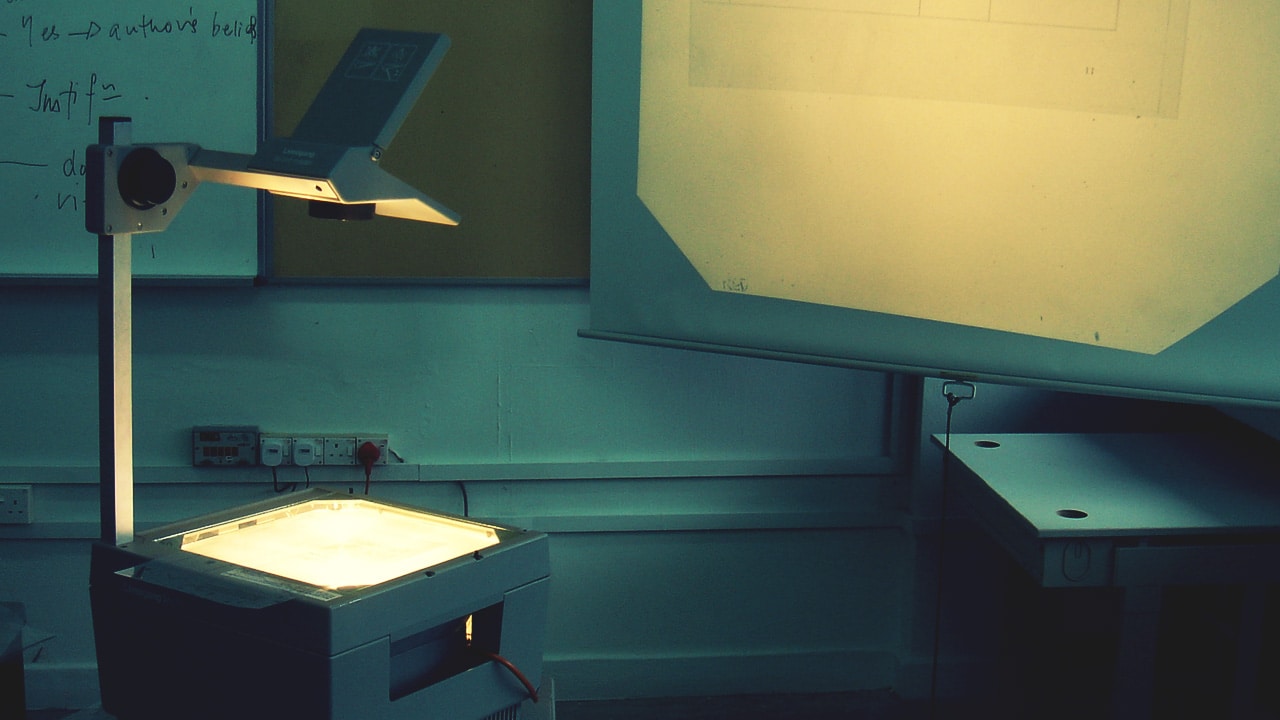 Overhead projectors, the official device of puppet shadows and markers and spray bottles. These projectors though simple and prehistoric, uphold an image of higher position. Even by it’s blocky and dull aesthetics gives these projectors a sense of authority. It is like George Orwell in his essay “Shooting an Elephant” in which he had to look calm and had a mission to uphold his power in front of the natives, even though deep down inside he hesitated shooting the beast down. Maybe it is because of context in which these overhead projects are portrayed in, or much how we expect and officer to uphold the law. We expect these devices to teach us as much as the teacher operating them. “For it is the condition of his rule that he shall spend his life trying to impress the 'natives,' and so in every crisis he has got to do what the 'natives' expect of him... A sahib has got to act like a sahib; he has got to appear resolute, to know his own mind and do definite things.” - George Orwell.
Overhead projectors, the official device of puppet shadows and markers and spray bottles. These projectors though simple and prehistoric, uphold an image of higher position. Even by it’s blocky and dull aesthetics gives these projectors a sense of authority. It is like George Orwell in his essay “Shooting an Elephant” in which he had to look calm and had a mission to uphold his power in front of the natives, even though deep down inside he hesitated shooting the beast down. Maybe it is because of context in which these overhead projects are portrayed in, or much how we expect and officer to uphold the law. We expect these devices to teach us as much as the teacher operating them. “For it is the condition of his rule that he shall spend his life trying to impress the 'natives,' and so in every crisis he has got to do what the 'natives' expect of him... A sahib has got to act like a sahib; he has got to appear resolute, to know his own mind and do definite things.” - George Orwell.
The history of the overhead projector is as simple and straightforward as the device itself. The first known projector was created by a french physicist named Edmund Becquerel in 1853 and demonstrated by a french instrument maker named Jules Duboscq in 1866. The actual overhead projector was designed in America by a scientist named Henry Morton and marketed it as a “vertical lantern” in 1880s. The viewfoil or viewgraphs, also known as transparent sheet, were largely developed in the United States. The reason was for wide use of the sheets and projectors was due to U.S. military training because of, you guessed it, World War II. After the dreaded war the overhead projectors were used in U.S. military academies. In the 1950s is when schools and business widely adopted the overhead projects. The projectors remained relevant in schools until the 21st century! These things remained as relevant as long as the pencil and paper.

Again the design of the overhead projector is a simple one. They take credit, design wise, from slide projectors. The bottom portion of the project where the viewgraphs are placed on the glass, is where the halogen lamp/s are located. These lamps tend to use up to 750 watts and get pretty hot and prolonged use, causing them to burn up prematurely and only last a few hundred hours. Some projectors included two lamps, so if one went out during a presentation a flick of a switch illuminated the other one and let the burnt up one cool. Once light goes through the viewgraph, it illuminates to the head which contains a mirror which reflects the light to a lense which magnifies the image and projects it to the wall. The device has an adjustable arm to adjust focus and even the head itself is adjustable to accommodate for different surfaces.

It is quite amazing to think that these devices lasted as long as they did. This could be because of the technological advancements like powerpoint did not come until the late 1990s and has not became widely used until mid 2000 and modern projectors at the time were the same price as a decent used car. The overhead projectors could be compared with the “Willy” Jeeps of World War II, reliable and respectable. Sure some may laugh because of outdated it is, just how the natives would laugh at Orwell if he would have ran away or get stomped on by the elephant, but at the end of the day just like the natives were also intimidated by Orwell because he was British officer with a gun, we also get intimidated when we see the teacher roll down the cart that the overhead projector is resting on wondering, baffled on what sort of assignment we as students are go to receive.
FUN FACT: The viewgraph on the projector has to be reversed because the image is flipped on the screen.
source: https://en.wikipedia.org/wiki/Overhead_projector#Decline_in_use
https://www.techwalla.com/articles/how-does-an-overhead-projector-work
Very informative and entertaining post. I like how you referenced George Orwell's essay "Shooting an Elephant."
ReplyDeleteI enjoyed reading your blog it was very informative. I also liked how you referenced “Shooting an Elephant.” It’s crazy how now we look back at the overhead projecter and laugh and are reminded of the days were we had to go up and write answers on the plastic sheets but at the time we were all nervous wondering what the overhead had in store for us.
ReplyDelete